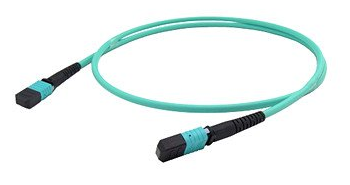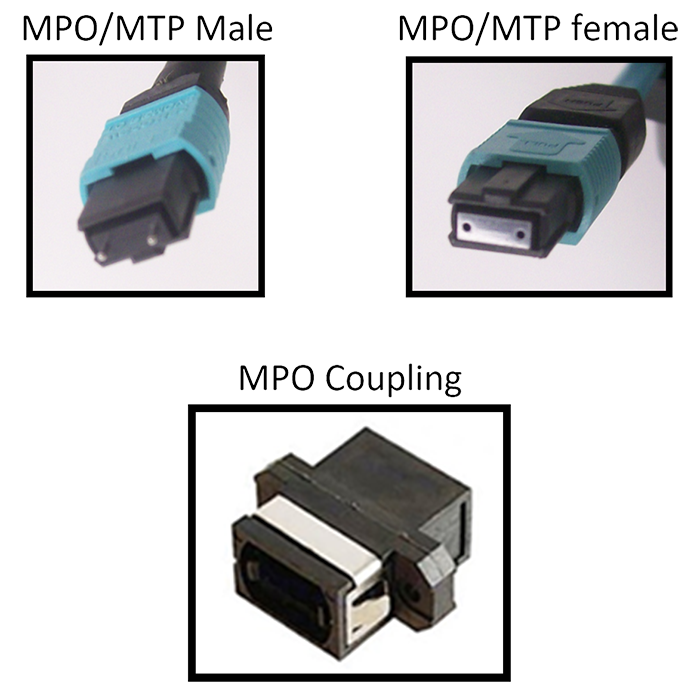Fiber cabling has been used in the data center for several decades now. This is nothing new. But what has changed over the past several years is the type of connectivity used today in the data center. In the past, it was commonplace to see fiber cable in bundles entering the data center with strands from 12 to 144 and beyond. Once these bundles entered the premise, they were housed in a fiber box or enclosure. At that time, the fiber bundle was broken down into its individual strands and eventually terminated with a fiber connector attached to the networking equipment. This is all well and good, but in more recent fiber installations, MPO truck cables are frequently used.

MPO/MTP fiber trunk cables are pre-terminated assemblies that use multi-fiber ribbon fiber cable with an MPO/MTP fiber connector. The MPO stands for "Multi-Fiber-Push-On," which is a generic-type fiber connector that commonly accepts 12 or 24 fiber strands. This connector, as the name states, pushes on (it connects in a similar way as a legacy SC-style fiber connector). MPO connectors are typically used in high-speed fiber backbone connectivity applications or anywhere you may need to connect multiple strands of fiber quickly. Oftentimes, users confuse the difference between MPO and MTP. MTP is another type of connector used in multiple fiber push-on connectivity applications. The MTP stands for "Multi-Fiber Termination Push-On" and is a registered trademark of the company "US Conec." MTP is a high-performance version of an MPO connector with "multiple engineered enhancements" to improve optical and mechanical performance when compared to a generic MPO connector. Since both the MPO/MTP connectors are available in 12- and 24-fiber strand connectivity, it's crucial to be aware that you cannot connect an MPO/MTP 12-strand connector to an MPO/MTP 24-strand connector. The rows of fiber strands will not line up correctly.

Just like any type of connector, both MPO/MTP are available with male and female ends. It's very critical to recognize the difference so you can avoid some common mistakes.
MPO/MTP male connectors have two alignment pins at the tip of the connector. These alignment pins are extremely important to make sure that the fiber strands of two mating MPO/MTP connectors align correctly. MPO/MTP female connectors have two holes to accept the alignment pins from a male connector. When a MPO/MTP male and female connector mate together, they must use an MPO coupling. This coupling is an open-ended piece of plastic that holds the MPO/MTP connectors of a trunk cable together. An MPO coupling joins MPO/MTP male and female connectors together. This is where the alignment pins are used to guarantee that the 12 or 24 fibers line up properly with minimal dB loss.

A common mistake that installers sometimes make is that they try to mate two MPO/MTP female connectors together with an MPO coupling. The connectors will fit together and you may think everything is OK, but no light will pass through the two mated MPO/MTP female connectors in the coupling. This is because the alignment pins are not present on one half of the coupling. So it's important to be aware of this and not make an innocent mistake while thinking your connectivity is good.
In recent years, newer fiber connectivity trends led to changing the type of connectivity used in the data center. Less common in today's data center are bulky fiber cable bundles housed in a fiber box or enclosure and later terminated with a fiber connector attached to the networking equipment. To quickly connect multiple strands of fiber together, pre-terminated MPO/MTP trunk cables and connectors are frequently used in modern data center applications. While both MPO/MTP cables are available with 12- and 24-fiber strands, the proprietary MTP connector delivers improved optical and mechanical performance when compared to a generic MPO connector. MTO/MTP male and female connectors must align properly so light passes successfully through each fiber connection, so it is important to know how the connectors mate with each other.

Product Engineer
Steve Molek has 27 years’ experience in the cabling and connectivity data communication industry. He started his career as a Technical Support Representative and now works as a Project Engineer for Black Box. As a Product Engineer, his primary focus is evaluating and testing all new cabling and connectivity products for sale by Black Box and training our inside technical support and sales teams. Steve also works directly with our domestic and international OEM suppliers as well as several nationally recognized third-party testing labs. Steve holds a B.S. degree in Mathematics and Computer Science from California University of Pennsylvania and an MBA from Waynesburg University.